Plastic-covered high tunnels (or “hoop houses”) are protected crop production structures commonly used for extending the growing season of high-value specialty crops, such as vegetables and small fruits, and for possibly improving plant productivity and produce quality (Frey et al. 2020; Tian et al. 2023). High tunnels may be considered an intermediate between highly controlled greenhouses and open fields that offer a certain level of environmental modification, protecting crops from rain, high wind, and extreme temperatures. Depending on the crops and markets, high tunnels can be used to promote early production or late harvest for enhanced profitability. The use of high tunnel growing systems as a conservation practice has been supported by the Natural Resources Conservation Service for over a decade (USDA-NRCS 2023).
To manage pests in high tunnels, natural pest control strategies, such as cultural control by manipulating the habitat, conservation biological control, and companion planting, are often favored over chemical pesticides. Thus, high tunnel cropping often consists of polycultures utilizing companion crops to attract and sustain beneficial insects, while repelling and trapping insect pests—a pest management technique commonly referred to as “push-pull” technology (Cook, Khan, and Pickett 2007; Khan et al. 2016). Furthermore, beneficial predatory insects are attracted and sustained by using flowering plants such as marigold (Tagetes erecta) and sweet alyssum (Lobularia maritima) as companion crops (Lopez and Liburd 2022; Legaspi, Miller, Kanga, et al. 2020). Therefore, “push-pull” technology may be complemented by companion planting of flowering refuge plants to enhance the effectiveness of biological control agents. This publication aims to introduce “push-pull” technology and companion planting for pest management to high tunnel vegetable growers and organic farmers. It may also be of interest to other crop producers wishing to improve their IPM practices.
“Push-pull” Technology and Companion Planting in High Tunnels in North Florida
At the Florida A&M University (FAMU) Research and Extension Center in Quincy, Florida, USDA-Agricultural Research Service (ARS) scientists and Extension faculty have been demonstrating the application of “push-pull” technology and companion planting in a high tunnel on tomato (Solanum lycopersicum) and leafy green crops. Based on preliminary studies, red giant mustard (Brassica juncea) plants are grown as the “push” factor around the inside perimeter of the high tunnel and interplanted with the lettuce (Lactuca sativa) or tomato (Legaspi 2010; Legaspi, Miller, Wolaver, et al. 2016; Legaspi and Simmons 2012). Trap crops may also be deployed as “pull” components to attract the pests where they may be controlled, preferably using biological methods such as biocontrol (Figure 1). Marigold and sweet alyssum may be planted as complementary natural refuge crops to nourish and shelter beneficial predatory insects (Figure 2).
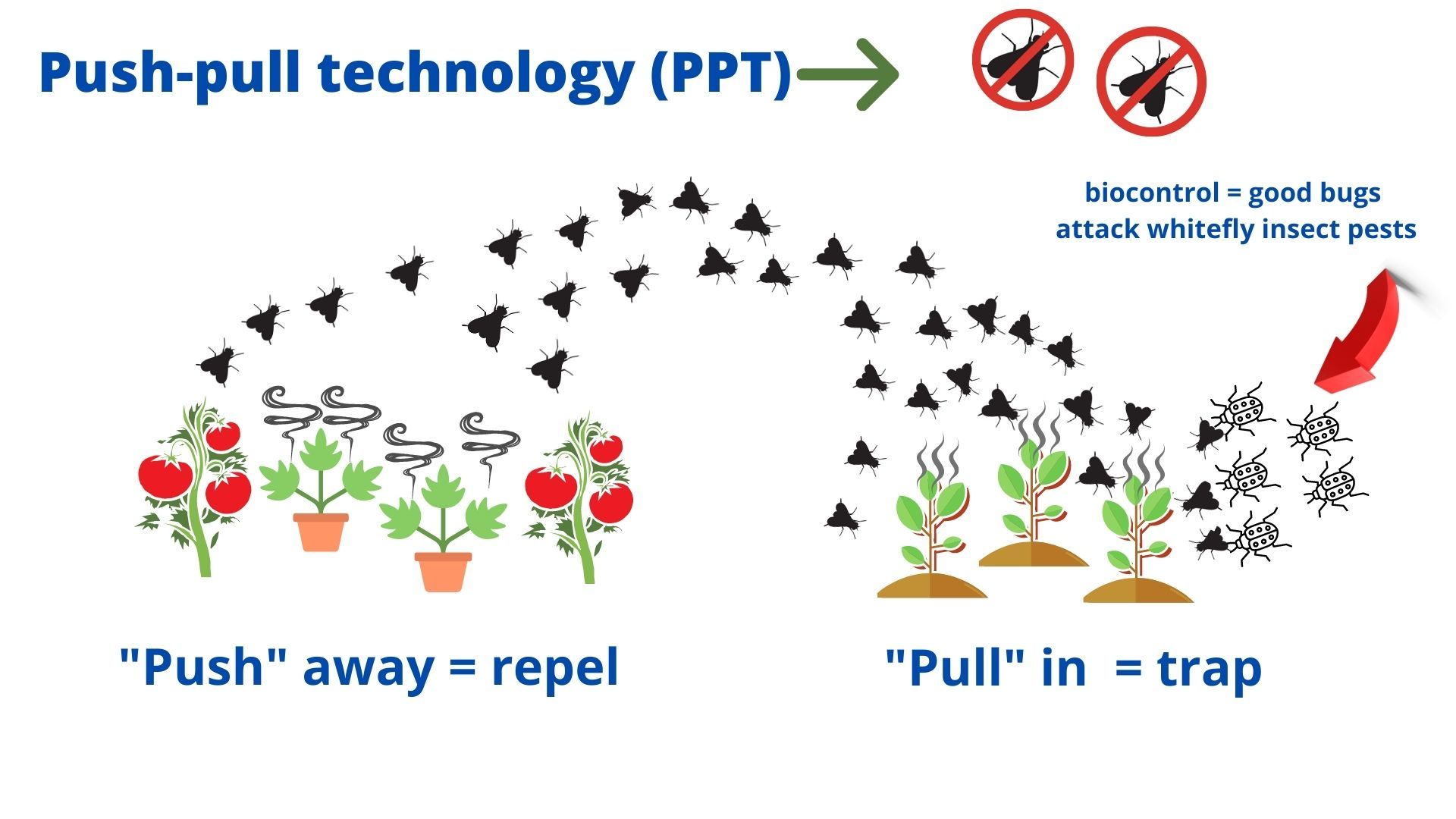
Credit: Jesusa C. Legaspi, USDA-ARS
In a separate study on tomato production in summer 2019, the combined use of “push-pull” technology with companion planting of flowering plants was evaluated in a top-vented high tunnel. Potted plants of society garlic (Tulbaghia violacea), citronella (Pelargonium citrosum), and lemongrass (Cymbopogon citratus) as “push” components were placed within a tomato crop, and green leaf volatiles such as leaf acetate (cis-3-hexenal acetate) were used as the “pull” factor to attract whiteflies to yellow sticky card traps. To enhance natural enemy populations, the companion flowering plants grown in the high tunnel along the sides included marigold (cv. French Marigold) together with potted basil (Ocimum basilicum cv. African Blue) placed at the corners. Commercial packets of the beneficial insect volatile attractant PredaLure® were set up next to the basil plants. A relatively low population of the major insect pests such as the sweetpotato whiteflies (Bemisia tabaci), aphids (i.e., Myzus persicae), and thrips (i.e., Frankliniella spp.) were all recorded on yellow sticky cards that were placed weekly throughout the season (Figures 3 and 4). The “pull” component using green leaf volatiles to attract whiteflies to yellow sticky card traps was not feasible for testing due to the low numbers of sweetpotato whiteflies in the high tunnel. The recorded beneficial insects consisted mainly of the minute pirate bug (Orius insidiosus) and whitefly parasites, including Encarsia spp. and Eretmocerus spp. (Figure 4; Legaspi, Miller, Kanga, et al. 2020).
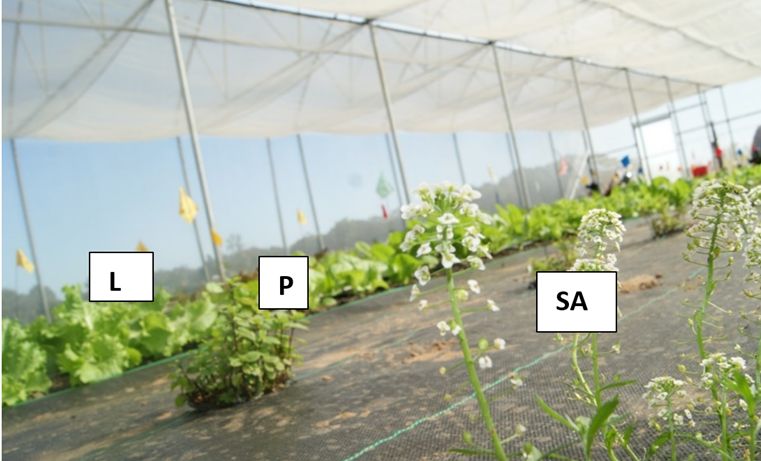
Credit: Used with permission from Alejandro Bolques, Florida A & M University
Companion Planting in High Tunnels in North Central Florida
In an organically managed high tunnel system at the UF/IFAS Plant Science Research and Education Unit in Citra, Florida, sweet alyssum was planted as a companion crop at the center and the border of the leafy green beds in fall 2020. Sweet alyssum continued to grow and flower during the production season of the subsequent tomato crop (December 2020–June 2021) (Figure 5). Insect pest and beneficial monitoring (using yellow sticky cards and visual inspection) during the leafy green and tomato growing seasons showed that sweet alyssum could attract multiple types of beneficial insects, including lady beetles (Coccinellidae), soldier beetles (Cantharidae), drone flies (Syrphidae), paper wasps (Vespidae), mud dauber wasps (Sphecidae), various parasitoid wasps (Braconidae), and green lacewings (Chrysopidae), to promote biological control and help reduce the pest population.
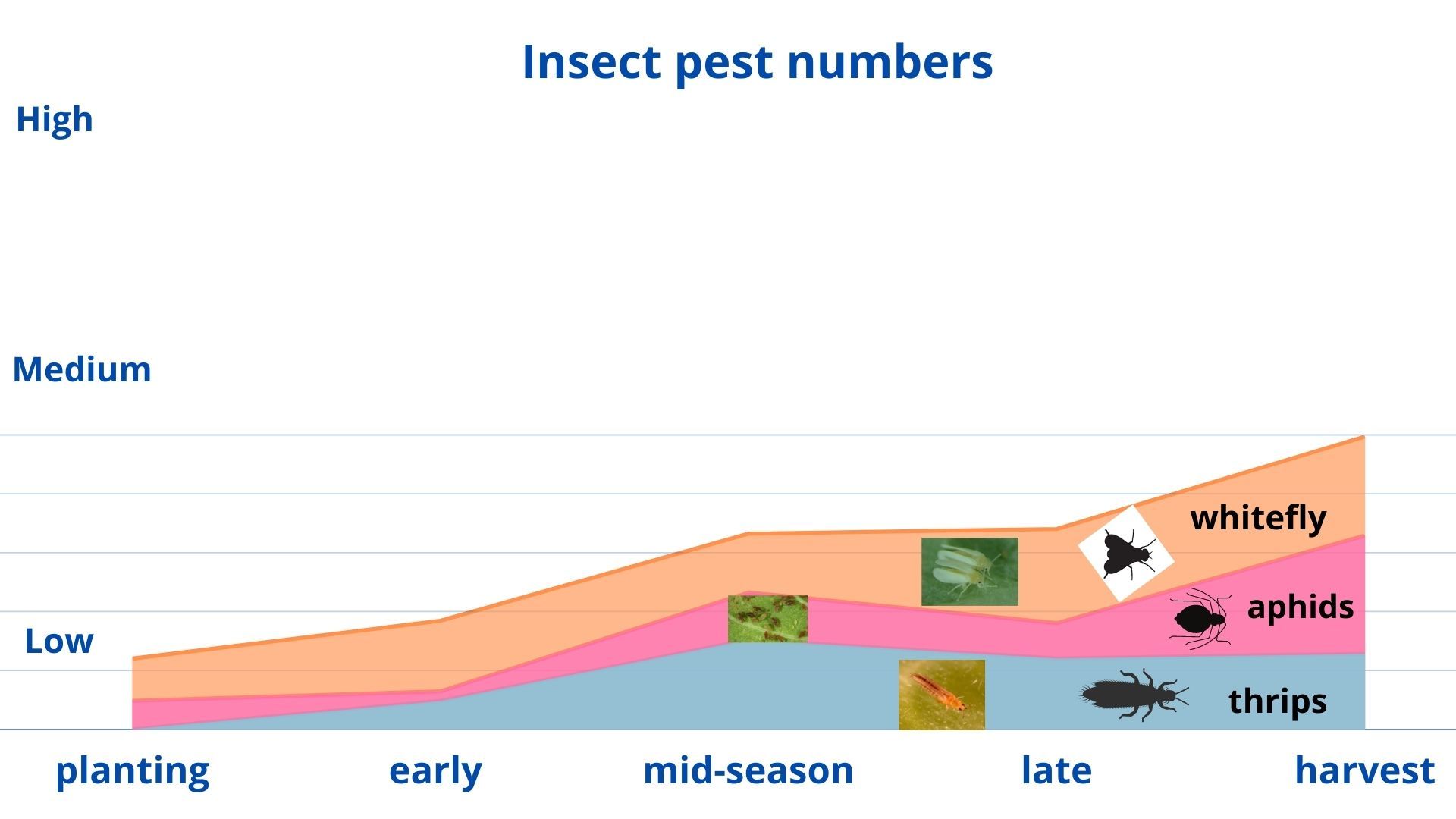
Credit: Jesusa C. Legaspi, USDA-ARS

Credit: Jesusa C. Legaspi and Ignacio Baez, USDA-ARS
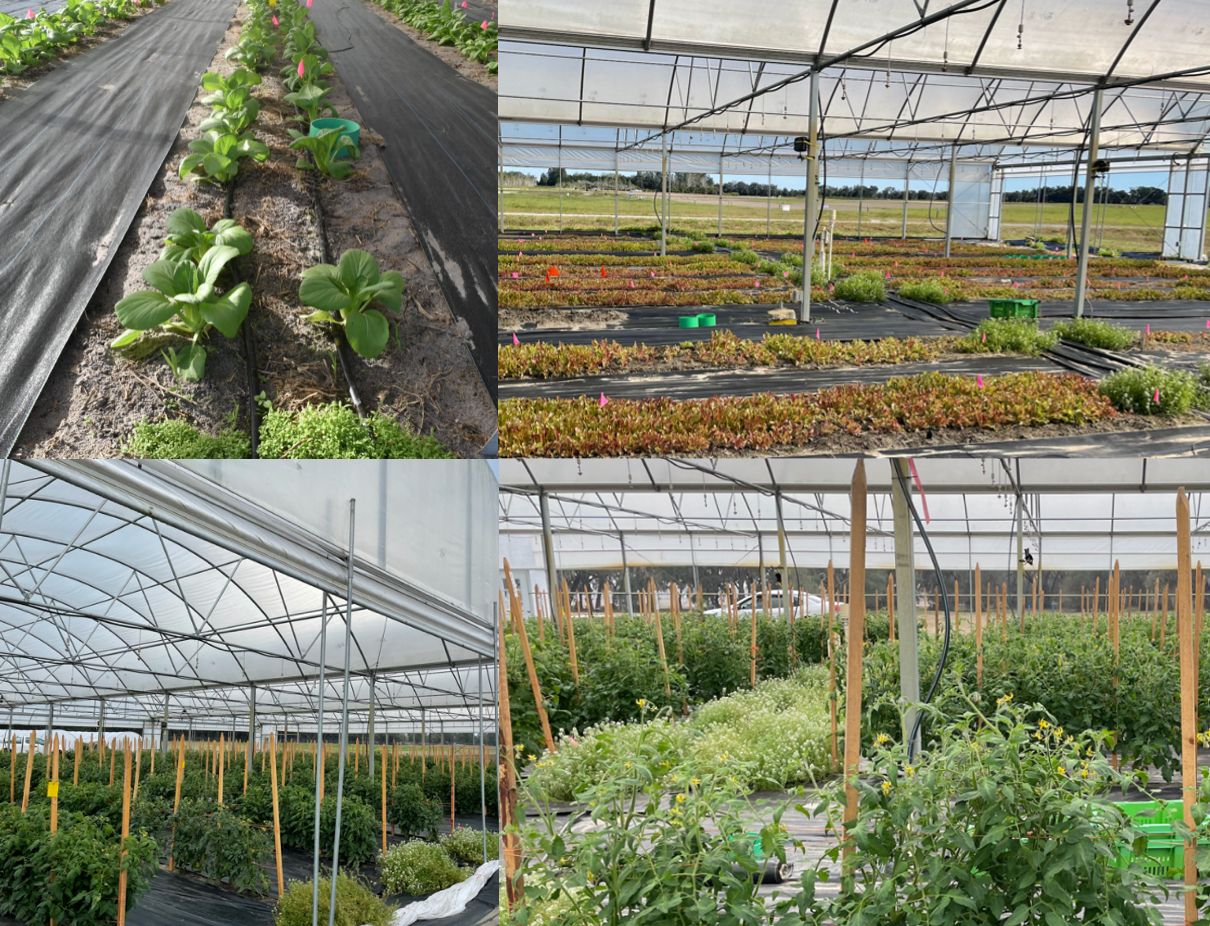
Credit: Shufang Tian, UF/IFAS
Companion Planting in High Tunnels in South Georgia
In summer and fall of 2020 and 2021 in South Georgia, marigold and sweet alyssum were planted along the sidewalls outside of the high tunnels to attract beneficial insects and to reduce the populations of sweetpotato whiteflies (Figure 6). Whiteflies cause enormous direct and indirect damage (as vectors of viral diseases) to field vegetable crops. One significant viral disease is Tomato Yellow Leaf Curl (TYLC). High tunnel tomatoes in 2019–2022 had 100% TYLC incidence on susceptible cultivars. Companion plants were planted in August 2020, but they were killed by a frost in January 2021. In October 2021, yellow sticky card samples indicated that the most abundant pests were sweetpotato whiteflies, followed by thrips, aphids, and leafhoppers (Cicadellidae). The beneficial insects were mainly parasitoid wasps (primarily Mymaridae, Encyrtidae, Scelionidae, Eulophidae, and Aphelinidae) followed by predatory flies (primarily Dolichopodidae and Syrphidae). Numerous beneficial insects (including pollinators) were observed to be attracted by the flowers (e.g., marigold) (Figure 7).
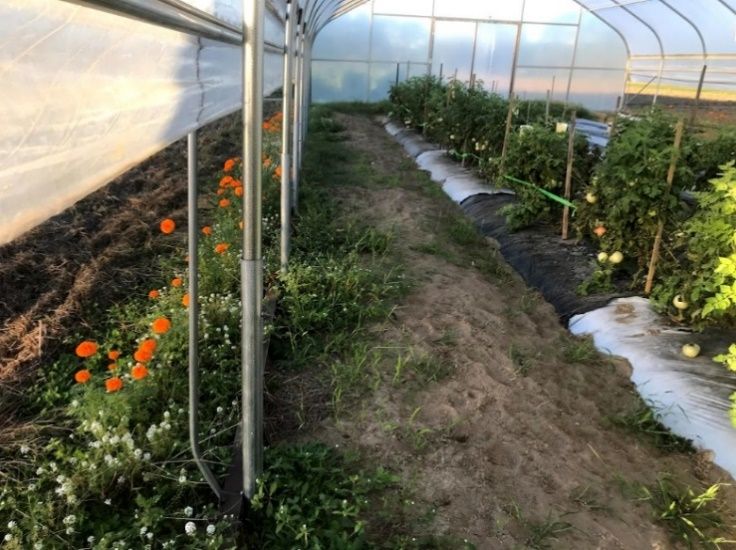
Credit: Used with permission from Juan C. Díaz-Pérez, University of Georgia

Credit: Used with permission from Juan C. Díaz-Pérez, University of Georgia
Summary
Based on our observations as well as the findings of other studies, the dual strategy of the combined use of “push-pull” technology and companion planting may be a low-cost, environmentally friendly tool for insect pest management that can be included in an arsenal of pest control tactics for high tunnel vegetable crops. In particular, it can be conveniently integrated into organic production systems for improved IPM management.
Acknowledgments
The high tunnel vegetable production research trials indicated in this publication were supported by the Organic Agriculture Research and Extension Initiative, project award no. 2017-51300-26813, from the U.S. Department of Agriculture's National Institute of Food and Agriculture.
The use of trade, firm, or corporation names in this publication is for the information and convenience of the reader. Such use does not constitute an official endorsement or approval by the U.S. Department of Agriculture or the Agricultural Research Service of any product or service to the exclusion of others that may be suitable.
References
Cook, S. M., Z. R. Khan, and J. A. Pickett. 2007. “The Use of Push-pull Strategies in Integrated Pest Management.” Annual Review of Entomology 52: 375–400. https://doi.org/10.1146/annurev.ento.52.110405.091407
Frey, C. J., X. Zhao, J. K. Brecht, D. M. Huff, and Z. E. Black. 2020. “High Tunnel and Grafting Effects on Organic Tomato Plant Growth and Yield in the Subtropics.” HortTechnology 30 (4): 492–503. https://doi.org/10.21273/HORTTECH04610-20
Khan, Z., C. A. O. Midega, A. Hooper, and J. Pickett. 2016. “Push-pull: Chemical Ecology-based Integrated Pest Management Technology.” Journal of Chemical Ecology 42: 689–697. https://doi.org/10.1007/s10886-016-0730-y
Legaspi, J. C. 2010. “A Preliminary Investigation of Giant Red Mustard (Brassica juncea) as a Deterrent of Silverleaf Whitefly Oviposition.” Journal of Entomological Science 45 (3): 262–271. https://doi.org/10.18474/0749-8004-45.3.262
Legaspi, J. C., and A. M. Simmons. 2012. “Evaluation of Selected Commercial Oils as Oviposition Deterrents against the Silverleaf Whitefly, Bemisia argentifolii (Hemiptera: Aleyrodidae).” Subtropical Plant Science 64: 49–53.
Legaspi, J. C., N. Miller, D. Wolaver, L. Kanga, M. Haseeb, and J. C. Zanuncio. 2016. “Repellency of Mustard (Brassica juncea) and Arugula (Eruca sativa) Plants, and Plant Oils against the Sweetpotato Whitefly, Bemisia tabaci (Hemiptera: Aleyrodidae).” Subtropical Agriculture and Environments 67: 28–34. https://www.subplantsci.org/wp-content/uploads/2016/05/SAE-Legaspi-ET-ALFINAL.pdf
Legaspi, J. C., N. Miller, L. H. B. Kanga, M. Haseeb, and J. C. Zanuncio. 2020. “‘Attract and Reward’ for Syrphid Flies using Methyl Salicylate and Sweet Alyssum in Kale in North Florida.” Subtropical Agriculture and Environments 71: 49–52. https://www.subplantsci.org/wp-content/uploads/2020/07/Legaspi-et-al.-2020.pdf
Lopez, L., and O. E. Liburd. 2022. “Can the Introduction of Companion Plants Increase Biological Control Services of Key Pests in Organic Squash?” Entomologia Experimentalis et Applicata 170 (5): 402–418. https://doi.org/10.1111/eea.13147
Tian, S., X. Zhao, I. R. Vincent, T. Gong, Z. T. Ray, J. Legaspi, A. Bolques, T. W. Coolong, and J. C. Díaz-Pérez. 2023. “Using High Tunnels to Enhance Organic Vegetable Production in Florida: An Overview: HS1466, 9/2023.” EDIS 2023 (5). https://doi.org/10.32473/edis-hs1466-2023
United States Department of Agriculture, Natural Resources Conservation Service (USDA-NRCS). “High Tunnel Initiative.” Assessed June 6, 2023. https://www.nrcs.usda.gov/wps/portal/nrcs/detailfull/national/programs/?cid=stelprdb1046250